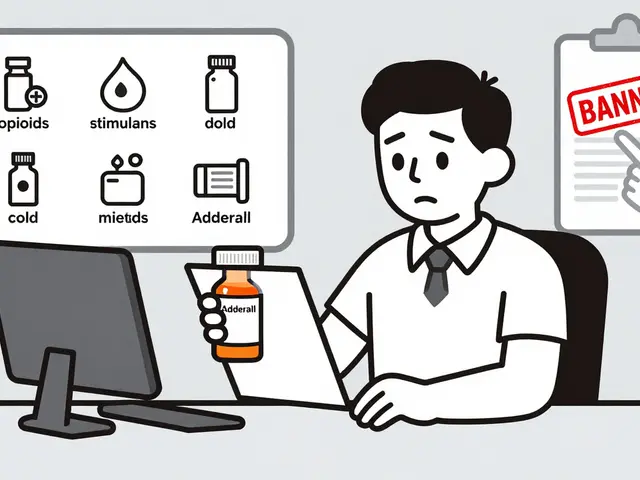Ceclor CD vs Other Antibiotics: Quick Comparison Tool
Comparison Results
When you need an antibiotic, the market feels like a maze of brand names, chemical codes, and dosage forms. Ceclor CD (Cefaclor) is a second‑generation cephalosporin used for a range of bacterial infections. It’s sold as a controlled‑release tablet, which makes dosing a bit smoother for adults. But is it the right choice for you, or do other drugs like Amoxicillin or Azithromycin provide better coverage, fewer side effects, or a cheaper price? This guide lines up the most common alternatives side‑by‑side, so you can see where Ceclor CD shines and where it falls short.
How Cefaclor Works
Cefaclor belongs to the cephalosporin family, which attacks bacterial cell walls by binding to penicillin‑binding proteins. This weakens the wall, causing the microbe to burst. Because it’s a second‑generation agent, it covers many gram‑positive organisms (like Streptococcus pneumoniae) and improves activity against some gram‑negative bugs (Haemophilus influenzae). Its controlled‑release design (the “CD” in the name) releases the drug slowly over 12‑hours, allowing twice‑daily dosing for most infections.
Key Decision Criteria
- Spectrum of activity: Which bacteria does the drug reliably kill?
- Dosage convenience: How many pills per day?
- Side‑effect profile: Risk of GI upset, allergic reactions, or C. difficile.
- Cost & insurance coverage: Out‑of‑pocket price for a typical course.
- Drug‑interaction risk: Does it clash with common meds like oral contraceptives or statins?
Direct Comparison Table
| Attribute | Ceclor CD (Cefaclor) | Amoxicillin | Azithromycin | Cephalexin | Doxycycline |
|---|---|---|---|---|---|
| Spectrum | Gram‑positive + moderate gram‑negative; good for ENT infections | Broad gram‑positive; limited gram‑negative | Broad gram‑positive & gram‑negative; atypical pathogens | Strong gram‑positive; limited gram‑negative | Broad, including atypicals; covers rickettsial diseases |
| Typical dose | 250‑500mg CD, twice daily | 500mg three times daily | 500mg once daily (5‑day course) | 500mg four times daily | 100mg twice daily |
| Common side‑effects | Diarrhea, nausea, rash | Diarrhea, allergic rash | GI upset, QT prolongation (rare) | Diarrhea, metallic taste | Photosensitivity, esophageal irritation |
| Cost (US$ per 10‑day course) | ≈$25‑$35 | ≈$12‑$18 | ≈$30‑$40 | ≈$15‑$22 | ≈$20‑$28 |
| Major drug interactions | Oral contraceptives (slight reduction in efficacy) | Probenecid, methotrexate | Warfarin, carbamazepine | Probenecid, warfarin | Calcium supplements, antacids (reduce absorption) |
When Ceclor CD Is the Right Pick
If your doctor diagnosed a middle‑ear infection, sinusitis, or a mild lower‑respiratory infection caused by Haemophilus influenzae or Moraxella catarrhalis, Ceclor CD often outperforms amoxicillin because it hits those gram‑negative culprits better. The twice‑daily schedule also helps patients who struggle with three‑ or four‑times‑daily pills. For adults without a history of severe penicillin allergy, it’s a solid middle‑ground choice-more potent than first‑generation cephalosporins yet not as pricey as azithromycin.

Overview of Popular Alternatives
Amoxicillin remains the go‑to for uncomplicated ear, throat, and urinary infections. Its cheap price and simple dosing make it a favorite for families, but it fails against β‑lactamase‑producing gram‑negative bugs.
Azithromycin shines when you need coverage for atypical organisms like Mycoplasma pneumoniae or when adherence is a concern-only one pill a day for five days. The downside is higher cost and a modest risk of heart rhythm changes.
Cephalexin is a first‑generation cephalosporin, excellent for skin and soft‑tissue infections but weaker against the gram‑negative organisms that Ceclor CD handles. Its four‑times‑daily schedule can be a hassle.
Doxycycline offers a broad spectrum, including tick‑borne diseases, and is taken twice daily. However, it can cause photosensitivity, making it less ideal for outdoor workers.
Potential Risks & How to Mitigate Them
All antibiotics carry a risk of disrupting the gut microbiome, potentially leading to Clostridioides difficile infection. Ceclor CD’s gastrointestinal side‑effects are similar to other β‑lactams-mostly mild diarrhea and nausea. Taking the drug with food reduces stomach upset. If you have a documented severe penicillin allergy, avoid Ceclor CD because cross‑reactivity can occur (roughly 5‑10% of penicillin‑allergic patients react to cephalosporins).
Renal impairment changes how Cefaclor is cleared. For patients with creatinine clearance below 30mL/min, dose reduction is recommended to prevent accumulation and toxicity.
Quick Decision Checklist
- Is the infection likely caused by Haemophilus or Moraxella? → Ceclor CD.
- Do you need a cheap, twice‑daily regimen for a streptococcal throat infection? → Amoxicillin.
- Is adherence a major barrier (e.g., travel, busy schedule) and atypical coverage needed? → Azithromycin.
- Are you treating a skin abscess with Staphylococcus aureus? → Cephalexin or Doxycycline depending on MRSA risk.
- Do you have a history of penicillin allergy? → Consider non‑β‑lactam options like Doxycycline, unless allergy testing is clear.
Bottom Line
Ceclor CD (Cefaclor) occupies a niche between cheap first‑line penicillins and pricey macrolides. It’s the go‑to when you need better gram‑negative coverage without the cost of azithromycin, and when twice‑daily dosing fits your lifestyle. For pure streptococcal infections, amoxicillin stays cheaper and just as effective. Always weigh spectrum, side‑effects, cost, and your personal health profile before starting any antibiotic.
Frequently Asked Questions
Can I take Ceclor CD if I’m allergic to penicillin?
About 5‑10% of people with a penicillin allergy also react to cephalosporins like Cefaclor. If your reaction was mild (rash), many doctors will still prescribe it, but a severe anaphylactic history warrants an alternative.
How long should I stay on Ceclor CD for a sinus infection?
Typical adult courses run 7‑10 days. The controlled‑release tablets are taken twice daily, so compliance is easier than three‑times‑daily regimens.
Is Ceclor CD more expensive than amoxicillin?
Yes. In the United States a 10‑day supply of Ceclor CD usually costs $25‑$35, whereas the same duration of amoxicillin is often under $20. Prices vary by country and insurance coverage.
Can I use Ceclor CD for a urinary tract infection?
Cefaclor isn’t first‑line for uncomplicated UTIs; agents like nitrofurantoin or trimethoprim‑sulfamethoxazole are preferred. It may be used if the pathogen is known to be susceptible.
What should I do if I develop diarrhea while on Ceclor CD?
Mild diarrhea is common and usually resolves after finishing the course. If you notice watery stools, fever, or abdominal cramping, contact your doctor-these could signal a C. difficile infection.






Erynn Rhode
Reading through the comparison, I couldn't help but notice just how nuanced the decision tree becomes when you factor in both pharmacodynamics and patient lifestyle; for instance, the twice‑daily dosing of Ceclor CD is a real blessing for those who struggle with adherence, especially when contrasted with the four‑times‑daily regimen of Cephalexin which can feel like a punishment for the gut.
On the other hand, the cost differential-Ceclor CD hovering around $25‑$35 per ten‑day course while Amoxicillin stays comfortably under $20-can be a decisive factor for uninsured patients.
The spectrum coverage is another critical point: Ceclor CD offers moderate gram‑negative activity, making it superior for ENT infections caused by Haemophilus influenzae, a nuance that Amoxicillin simply doesn't capture.
Side‑effect profiles also align surprisingly well; both Ceclor CD and Amoxicillin list diarrhea and rash as common, yet Ceclor CD adds nausea and a slight risk of rash, which is still manageable with food.
Interactions with oral contraceptives are modest for Ceclor CD, whereas Amoxicillin’s list includes probenecid and methotrexate, which could be problematic for patients on those drugs.
When you consider patient-specific factors like renal function, dosage adjustments become essential; Ceclor CD requires dose reduction below a creatinine clearance of 30 mL/min, a detail often overlooked in primary care.
Moreover, the controlled‑release formulation of Ceclor CD smooths plasma peaks and troughs, potentially reducing the likelihood of C. difficile overgrowth compared to immediate‑release agents.
The table also highlights Azithromycin’s QT‑prolongation risk, a serious concern for patients with existing cardiac conditions, which Ceclor CD sidesteps entirely.
From a public‑health perspective, the broader gram‑negative coverage of Ceclor CD could help reduce the spread of resistant strains if used judiciously, though misuse could backfire.
In terms of adherence, the convenience of a twice‑daily schedule cannot be overstated; many patients report missing doses with three‑ or four‑times‑daily regimens, leading to sub‑therapeutic exposure and resistance.
The price point, while higher than Amoxicillin, is still lower than the typical $30‑$40 cost of a ten‑day Azithromycin course, positioning Ceclor CD as a middle‑ground option.
For skin and soft‑tissue infections, however, Cephalexin’s strong gram‑positive activity may still be the preferred choice, especially when MRSA is not a concern.
Doxycycline’s unique coverage of atypical pathogens and tick‑borne diseases makes it invaluable in certain geographic regions, something Ceclor CD does not provide.
Ultimately, the decision hinges on the infection site, likely pathogens, patient comorbidities, and financial constraints-no single antibiotic reigns supreme in every scenario. 🙂
Rhys Black
One cannot simply wade into the labyrinth of antibiotics with a cavalier attitude; the moral imperatives demand that we scrutinize each molecule with the rigor of a jurist and the flair of a tragedian. The author of this guide, bless their earnest effort, nevertheless skirts the ethical quagmire of over‑prescribing, a practice that gnaws at the very foundations of antimicrobial stewardship. Ceclor CD, with its respectable gram‑negative reach, may appear as a noble champion against ENT foes, yet its cost and controlled‑release nature hint at a subtle, market‑driven allure. Let us not be beguiled by such gilded promises, for the cheap, reliable Amoxicillin often suffices when the pathogen is plainly gram‑positive, and the needless elevation of price becomes a silent indictment of pharmaceutical profiteering. The comparison table, while meticulously compiled, omits the broader societal repercussions of fostering resistance-a tragic omission that should be rectified with solemn gravity.
Abhishek A Mishra
i think the table is pretty helpful for picking the right med, especially when you gotta think about side effects and cost. for ear infections, ceclor cd looks solid 'cause it hits the gram‑negative bugs better. also, taking it twice daily is easier than some of the four‑times‑daily options. just make sure you finish the whole course so the infection doesn't come back.
Jaylynn Bachant
the dance of molecules within our bodies is nothing short of a cosmic dialogue, where ceclor cd whispers to bacterial walls, coaxing them to unravel. yet we, as mere mortals, reduce this poetry to tables of cost and dosage, forgetting the silent symphony that underlies each prescription. perhaps the true wisdom lies not in the number of grams, but in the humility with which we approach each cure.
Anuj Ariyo
The chart does a solid job, it’s clear, it’s concise, and it lets you see at a glance which drug hits which bugs, the price tags, and the dosing schedule, which is handy when you’re juggling a busy day, and the side‑effects are listed right there, no need to hunt through a bunch of PDFs, which saves time, which is always a plus.
Tom Lane
Great effort on laying out the side‑by‑side data. This makes it much easier for anyone trying to decide between Ceclor CD and the other options. The dosage frequency really matters for compliance, and the cost breakdown helps when insurance doesn’t cover everything. It’s also useful to see the interaction notes right up front. Thanks for putting this together!
Darlene Young
Building on that, it’s worth noting that Ceclor CD’s controlled‑release formulation isn’t just a convenience-it actually smooths plasma concentrations, potentially lowering peak‑related side effects. Moreover, for patients with a history of mild GI upset on Amoxicillin, the gradual release can be gentler on the stomach. If cost is a concern, remember many pharmacies offer discount cards that can bring the $25‑$35 range down closer to generic amoxicillin prices.
Steve Kazandjian
Ceclor CD works well for ear infections.
Roger Münger
From a pharmacological standpoint, Ceclor CD (cefaclor) is a second‑generation cephalosporin with a spectrum that bridges the gap between first‑generation agents and broader‑spectrum penicillins. Its minimum inhibitory concentrations (MICs) against Haemophilus influenzae are typically ≤2 µg/mL, which is clinically relevant for sinusitis. The drug’s renal elimination half‑life is approximately 1 hour in patients with normal clearance, justifying the twice‑daily dosing schedule. Notably, Ceclor CD does not possess significant activity against Pseudomonas aeruginosa, a limitation shared with many oral cephalosporins. Drug‑interaction potential is modest, with the primary concern being a modest reduction in oral contraceptive efficacy.
Gerald Bangero
It’s encouraging to see such a thorough breakdown-knowledge like this empowers patients to make smarter choices, and that’s truly uplifting. When we consider the bigger picture, each thoughtful prescription contributes a small ripple toward preserving antibiotic effectiveness for future generations. Even the occasional typo in the chart reminds us that humanity is involved, imperfect yet striving. Keep sharing these insights; they’re the bright spots that guide us through the maze of modern medicine.
John Nix
With due respect to the contributions presented herein, I would like to underscore the importance of adhering strictly to evidence‑based guidelines when selecting an antimicrobial agent. The comparative data provided is valuable; however, clinical judgment must remain paramount, particularly in the context of individual patient comorbidities and local resistance patterns. I appreciate the effort invested in compiling this resource.
Mike Rylance
Thank you for your measured appraisal. Your reminder about local susceptibility trends is essential, as regional variations can indeed shift the risk‑benefit calculus for agents such as Ceclor CD versus amoxicillin. Maintaining a vigilant stance on stewardship aligns perfectly with our shared goal of optimal patient outcomes.
Becky B
Look, the pharma giants aren't just selling meds; they're pushing a narrative that you need the newest, most expensive drug to stay healthy. Ceclor CD's price tag is a clear sign they're cashing in on people’s fear of infections, while cheaper, proven antibiotics sit on the shelves gathering dust. If you think the system is designed to protect you, think again-it's all about profit.
Aman Vaid
While the conspiratorial tone is noted, the factual inaccuracies concerning cephalosporin safety are concerning. The literature unequivocally demonstrates that cross‑reactivity with penicillin allergy is limited to a small subset, and the efficacy of Ceclor CD in ENT infections is well‑documented. Overstating speculative risks may deter appropriate therapy.
xie teresa
I hear the concerns about cost and safety, and I think it’s important we balance skepticism with empathy. Many patients rely on affordable options like amoxicillin, yet others truly benefit from the broader coverage Ceclor CD provides. Let’s keep the conversation respectful and focused on evidence.
Srinivasa Kadiyala
Interesting perspective, but I would argue that the table oversimplifies the complexity of real‑world prescribing; the pharmacokinetics, patient adherence, and local resistance patterns all intertwine, making a binary cost‑versus‑coverage analysis insufficient; therefore, clinicians should interpret such data with caution.
Alex LaMere
Minor typo: "Ceclor CD" should be consistently capitalized throughout. Also, the dosage column for azithromycin could specify the 5‑day regimen more clearly. 😊
Dominic Ferraro
Great catch! Those little details matter, and fixing them makes the guide even more reliable. Thanks for sharpening the content; clarity helps everyone make better decisions.
Jessica Homet
Honestly, these tables just give a false sense of control; the real world throws bacteria at us that don’t care about our spreadsheets, and we end up chasing shadows while the microbes keep evolving.